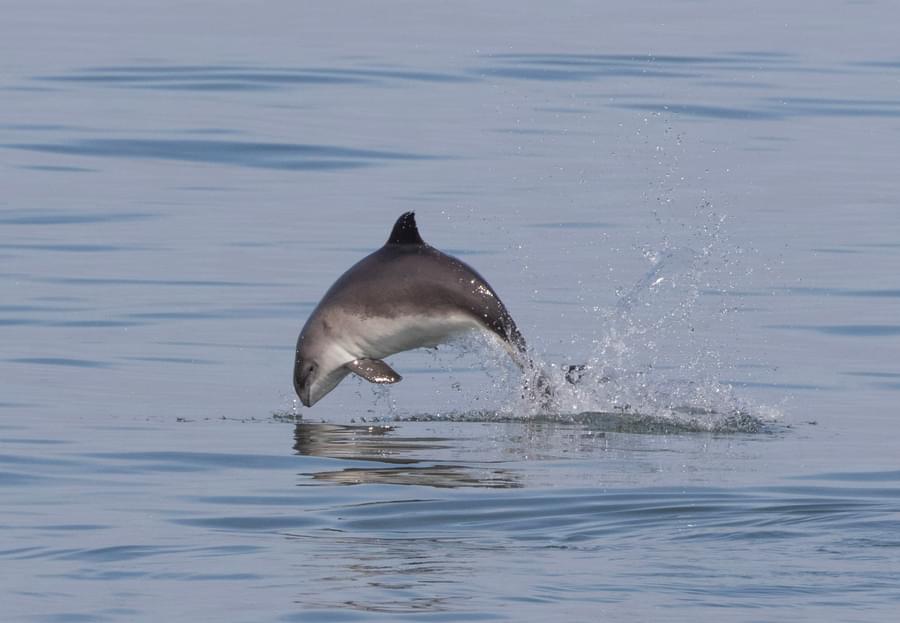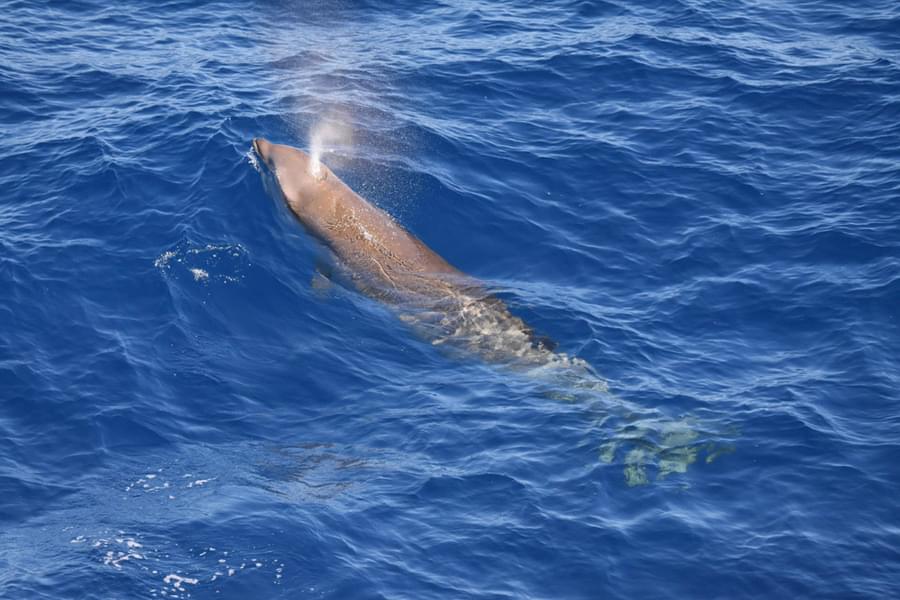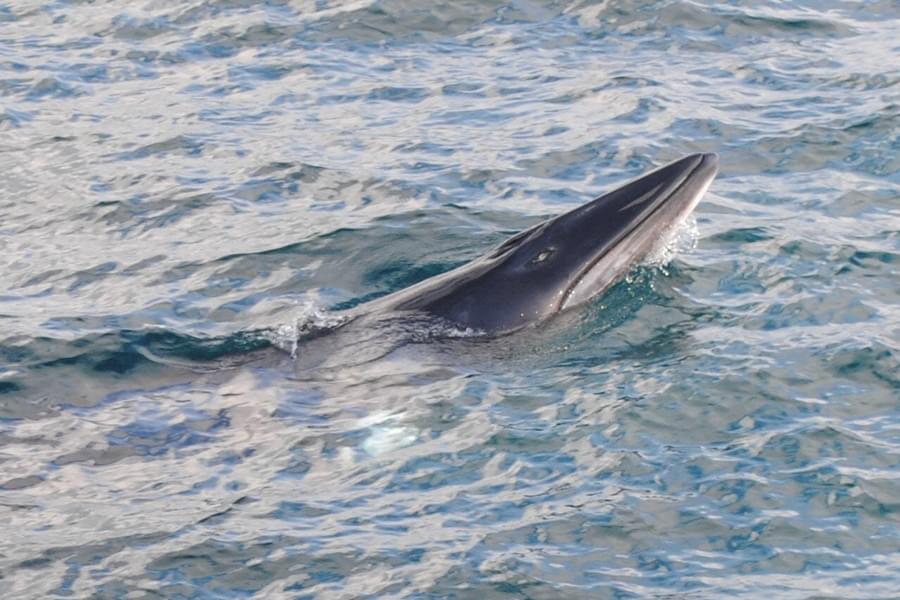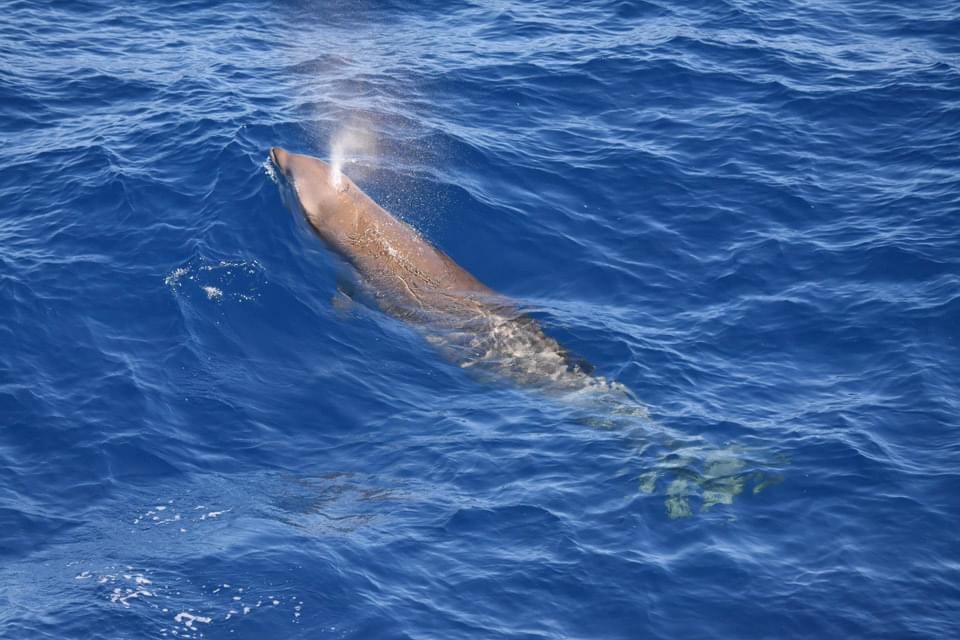Home to around a third of the world’s cetacean species (30/90 species), the Bay of Biscay is one of the most remarkable and reliable places to spot whales and dolphins. The warm and cold waters combining in and amongst the deep water canyons act as a massive ‘mixing bowl’ for life! These rich-in-nutrient waters attract whales and dolphins from around the globe. After travelling along this route for only a couple of weeks, I am privileged to have had some amazing sightings already.
The coastal waters of the channel are relatively shallow, reaching 200m, but progressing around the continental shelf edge drop to 1000m. The beautiful bay itself falls to around 2000m, and just to blow your mind more, its deep canyons and trenches descend to around 4000m deep, perfect for our deep-diving whales!
Harbour porpoise (Phocoena phocoena) – coastal waters
The smallest cetacean, reaching up to 1.7m – the average size of a human, and one of the UK’s most common sightings. They are easily identifiable by their perfectly triangular-shaped dorsal fin – a key feature differentiating them from dolphins. They are the shyest of the cetaceans, often travelling in small groups between 1-4, however, can be seen in larger pods of 50+ individuals, depending on the time of the season. Despite their shyness, they are often witnessed doing a distinctive rolling, surfacing sequence – very different from the acrobatics of the dolphins.

Common dolphin (Delphinus delphis) – all around
Our smallest dolphin species, reaching only 2m in length, is one of the most distinctive animals, which can be seen all year round. With their beautiful yellow-light grey hourglass pattern on their sides, which is remarkable to see as they athletically leap out of the water, playing amongst the waves. They are a highly social species, often seen in groups of around 4-30, but can be spotted in ‘superpods’, amassing in numbers of 50-100+. – On one of my last journeys over Biscay, I was lucky enough to witness two superpods one after the other, resulting in over 300 dolphins in less than an hour.
Bottlenose dolphin (Tursiops truncates)– all around
Reaching up to 4m in length, bottlenose dolphins are often the ones we think of when we think of dolphins, with their uniform grey colouration. Much like the common dolphin, bottlenoses are a social species, often in pods between 4-20 but can also be seen in ‘superpods’ of 50+. They are often seen energetically porpoising through the water.
Striped dolphin (Stenella coeruleoalba) – Continental shelf edge onwards
Reaching up to 2.5m in length, this can be one of the most charismatic species to spot, with
their distinctive strip running from their beaks across the side of their body. Being such highly social species, they are seen in pods between 4-30, or ‘superpods’ from 50+. Striped dolphins can even be found in mixed species pods with common dolphins, where both species will show off their acrobatic skillsets through/out of the water.
Minke whale (Balaenoptera acutorostrata) – all around
The smallest of the baleen whales reaching around 10m in length. Their individual surfacing sequence and their white patches on their pectoral fins allow them to be highly distinctive.
Fin whale (Balaenoptera physalus) – Bay of Biscay
Despite these being the second largest animal on the planet, reaching around 27m in length, there is surprisingly little known about these magnificent beings. They migrate through Biscay between June – September but can be spotted along the continental shelf edge all year round. Their asymmetrical jaw colouration (left-grey, right-white) is the perfect feature to allow them to be such successful hunters. When hunting, they will swim on their sides with the white half facing below, making fish believe they are swimming toward the water surface when in fact, they are swimming into the mouth of a hungry fin whale.
Long-finned pilot whale (Globicephela melas) – Bay of Biscay
Although named a ‘whale’, pilot whales are actually the second largest dolphin species, reaching around 7.5m in length. They are a highly social species, often seen in groups ranging anywhere between 3-20 individuals; the social bonds created between family members in a pod is so strong, there is virtually nothing a pilot whale wouldn’t do for its ‘loved one’.
Sperm whale (Physeter microcephalus) – Bay of Biscay and deep canyons
Reaching 20m in length, these magnificent creatures are one of the largest toothed whales who specialise in deep diving. They feed on the deep diving squid found at the depths of the canyons. They have been known to hold their breath for approximately an hour! They can be seen in groups ranging from 10-30 individuals, with very distinctive blow patterns; due to the location of their blow-hole, their blows will be at a 45° angle slightly toward the front.
Cuvier’s beaked whale (Ziphius cavirostris) – Bay of Biscay and deep canyons
Also known as the ‘goose-faced whale’, due to its size and colouration and reaching only 7m in length, this peculiar whale is known to be one of the deepest diving species. Incredibly, it has been recorded holding its breath for around three hours, with a dive reaching approximately 2998m! An inquisitive creature who believes they are as athletic as a dolphin leaping out of the water, only their attempt is more like an awkward belly flop!
Conservation and threats
Although these species are miraculous to see in the wild, they do still face some threats to their survival. These range from plastic pollution and entanglement (i.e., minke whales), to noise disturbance, to climatic changes; our larger baleen whales (i.e., fin whales, humpback whales, minke whales etc.) face more challenges, including ship strike. However, with the growing number of collaborations between ORCA and its partners, we are making meaningful progress in addressing these threats.






.jpg?w=900&h=600&q=85&auto=format&fit=crop&dm=1685951507&s=0267375b247640e018131d45f2d395de)


